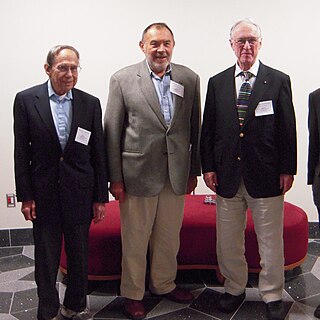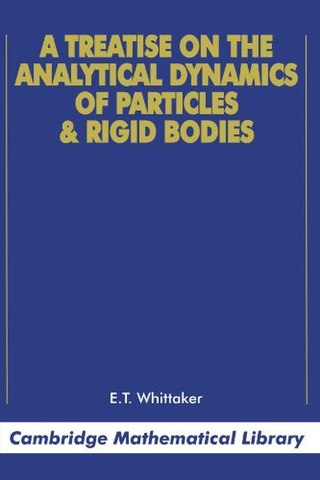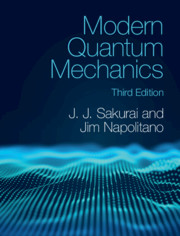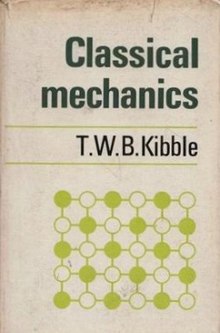
Quantum mechanics is a fundamental theory in physics that describes the behavior of nature at and below the scale of atoms. It is the foundation of all quantum physics, which includes quantum chemistry, quantum field theory, quantum technology, and quantum information science.

The Schrödinger equation is a linear partial differential equation that governs the wave function of a quantum-mechanical system. Its discovery was a significant landmark in the development of quantum mechanics. It is named after Erwin Schrödinger, who postulated the equation in 1925 and published it in 1926, forming the basis for the work that resulted in his Nobel Prize in Physics in 1933.
In theoretical physics and mathematical physics, analytical mechanics, or theoretical mechanics is a collection of closely related formulations of classical mechanics. Analytical mechanics uses scalar properties of motion representing the system as a whole—usually its kinetic energy and potential energy. The equations of motion are derived from the scalar quantity by some underlying principle about the scalar's variation.

In physics, canonical quantization is a procedure for quantizing a classical theory, while attempting to preserve the formal structure, such as symmetries, of the classical theory to the greatest extent possible.

Sir Thomas Walter Bannerman Kibble was a British theoretical physicist, senior research investigator at the Blackett Laboratory and Emeritus Professor of Theoretical Physics at Imperial College London. His research interests were in quantum field theory, especially the interface between high-energy particle physics and cosmology. He is best known as one of the first to describe the Higgs mechanism, and for his research on topological defects. From the 1950s he was concerned about the nuclear arms race and from 1970 took leading roles in promoting the social responsibility of the scientist.

A dynamical billiard is a dynamical system in which a particle alternates between free motion and specular reflections from a boundary. When the particle hits the boundary it reflects from it without loss of speed. Billiards are Hamiltonian idealizations of the game of billiards, but where the region contained by the boundary can have shapes other than rectangular and even be multidimensional. Dynamical billiards may also be studied on non-Euclidean geometries; indeed, the first studies of billiards established their ergodic motion on surfaces of constant negative curvature. The study of billiards which are kept out of a region, rather than being kept in a region, is known as outer billiard theory.

Herbert Goldstein was an American physicist and the author of the standard graduate textbook Classical Mechanics.

The Arnowitt–Deser–Misner (ADM) formalism is a Hamiltonian formulation of general relativity that plays an important role in canonical quantum gravity and numerical relativity. It was first published in 1959.

Classical Mechanics is a textbook written by Herbert Goldstein, a professor at Columbia University. Intended for advanced undergraduate and beginning graduate students, it has been one of the standard references on its subject around the world since its first publication in 1950.

Classical mechanics is a physical theory describing the motion of objects such as projectiles, parts of machinery, spacecraft, planets, stars, and galaxies. The development of classical mechanics involved substantial change in the methods and philosophy of physics. The qualifier classical distinguishes this type of mechanics from physics developed after the revolutions in physics of the early 20th century, all of which revealed limitations in classical mechanics.
In general relativity, the Hamilton–Jacobi–Einstein equation (HJEE) or Einstein–Hamilton–Jacobi equation (EHJE) is an equation in the Hamiltonian formulation of geometrodynamics in superspace, cast in the "geometrodynamics era" around the 1960s, by Asher Peres in 1962 and others. It is an attempt to reformulate general relativity in such a way that it resembles quantum theory within a semiclassical approximation, much like the correspondence between quantum mechanics and classical mechanics.
In theoretical physics, Hamiltonian field theory is the field-theoretic analogue to classical Hamiltonian mechanics. It is a formalism in classical field theory alongside Lagrangian field theory. It also has applications in quantum field theory.
Frank H. Berkshire is a British mathematician, an expert on fluid dynamics, biomechanics, and the mathematics of gambling. He is also known as a coauthor of the textbook Classical Mechanics.

Classical Electrodynamics is a textbook written by theoretical particle and nuclear physicist John David Jackson. The book originated as lecture notes that Jackson prepared for teaching graduate-level electromagnetism first at McGill University and then at the University of Illinois at Urbana-Champaign. Intended for graduate students, and often known as Jackson for short, it has been a standard reference on its subject since its first publication in 1962.

Mathematical Methods of Classical Mechanics is a textbook by mathematician Vladimir I. Arnold. It was originally written in Russian, and later translated into English by A. Weinstein and K. Vogtmann. It is aimed at graduate students.
In quantum mechanics, a quantum speed limit (QSL) is a limitation on the minimum time for a quantum system to evolve between two distinguishable (orthogonal) states. QSL theorems are closely related to time-energy uncertainty relations. In 1945, Leonid Mandelstam and Igor Tamm derived a time-energy uncertainty relation that bounds the speed of evolution in terms of the energy dispersion. Over half a century later, Norman Margolus and Lev Levitin showed that the speed of evolution cannot exceed the mean energy, a result known as the Margolus–Levitin theorem. Realistic physical systems in contact with an environment are known as open quantum systems and their evolution is also subject to QSL. Quite remarkably it was shown that environmental effects, such as non-Markovian dynamics can speed up quantum processes, which was verified in a cavity QED experiment.

A Treatise on the Analytical Dynamics of Particles and Rigid Bodies is a treatise and textbook on analytical dynamics by British mathematician Sir Edmund Taylor Whittaker. Initially published in 1904 by the Cambridge University Press, the book focuses heavily on the three-body problem and has since gone through four editions and has been translated to German and Russian. Considered a landmark book in English mathematics and physics, the treatise presented what was the state-of-the-art at the time of publication and, remaining in print for more than a hundred years, it is considered a classic textbook in the subject. In addition to the original editions published in 1904, 1917, 1927, and 1937, a reprint of the fourth edition was released in 1989 with a new foreword by William Hunter McCrea.

Modern Quantum Mechanics, often called Sakurai or Sakurai and Napolitano, is a standard graduate-level quantum mechanics textbook written originally by J. J. Sakurai and edited by San Fu Tuan in 1985, with later editions coauthored by Jim Napolitano. Sakurai died in 1982 before he could finish the textbook and both the first edition of the book, published in 1985 by Benjamin Cummings, and the revised edition of 1994, published by Addison-Wesley, were edited and completed by Tuan posthumously. The book was updated by Napolitano and released two later editions. The second edition was initially published by Addison-Wesley in 2010 and rereleased as an eBook by Cambridge University Press, who released a third edition in 2020.













